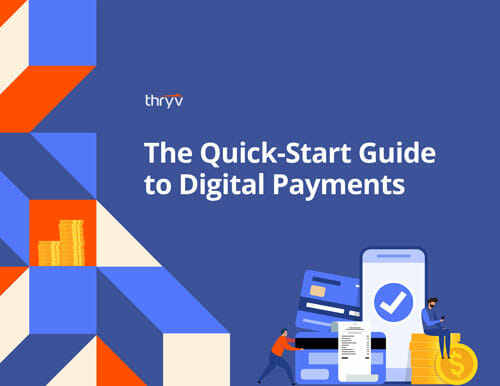Pricing directly affects your revenue, but the dollar amount can’t be the only thing guiding us. Your deal versus a competitor’s, your free offers, and your ability to fit most budgets are all things customers use to learn about your business and influence your bottom line.
In our latest webinar, Business Transformation Expert, Carl Gould, shares five of his best tips for leveraging what your pricing says about your business – and quickly increasing your revenue, no matter what the market is doing.

Free: Quickstart Guide to Digital Payments
DownloadTip 1: What Are Your Customers Saying?
You can only expect your business to perform well if you know what your customers want. Gould advises you to seek out the complaints, questions, and kudos within your industry and listen to what customers say.
When you understand what your customers expect, you can figure out how to solve their problems and replicate your successes. You can also discover what competitors are doing and do it better, Gould says — or even what competitors aren’t doing for their customers, that you can do for yours.
Examples of these extra measures might include:
- In-house financing
- Expedited service for a small fee
- Long- and short-term freemium offers
- Preferred customer memberships/benefits
- Guaranteed arrival or appointment time
Tip 2: Ordering From the Menu
Structure your pricing like a restaurant menu. Gould calls it “flexible consumption.” There is something for everyone at multiple price points, which helps draw interest from various potential customers.
But the most important part of your flexible pricing structure might be your the least expensive offering. That’s because your middle- and top-tier offerings might be too big a leap for a customer who’s choosing your business for the first time. Figure out the smallest thing you can sell, so potential customers can try you out before committing to something more serious.
Tip 3: Everyone Loves a List
When customers search for a business, they ask questions to find a professional who knows the answer. So why don’t you answer their questions before they ask? You don’t need a crystal ball; you just have to know your industry to increase your revenue.
Gould advises listing the top five complaints you hear about businesses in your industry and writing a short blog on how you solve each one. It also does not hurt to explain the benefits of choosing your business as the solution.
After you write the blog, publish it on your website, share it on social, include it in your newsletter, etc. How ever you can get the word out, do it. Listicles and FAQ blogs can improve search results because consumers often ask questions directly to Google, and your content might have the answer they are looking for.
Tip 4: Premium Offering for a Premium Business
A higher price typically indicates higher quality and vice versa. That is why you absolutely must have a premium offering in your business, Gould says.
“You should still present medium-priced and low-priced offerings, but by setting a high price, you’re saying you’re better quality than the competition,” he continues.
During volatile times, people will pay more for your service if they believe you will fix their problem the first time … Not because they have extra money, but because they only have one chance with their money and can’t afford [for] it to go wrong.
Consumers often want to make premium purchases regardless of the economic climate. If you are not offering premium-priced services because the market is sideways, or trending down, you might be overlooked.
Tip 5: Teamwork Makes the Dream Work
Gould’s final tip to increase your revenue is to partner with a business that has an overlapping clientele and advocate for each other.
For instance, someone who sells homeowners insurance could partner with various residential-based businesses like plumbers, landscapers, and roofers — because they both serve similar customers.
When working with your customers, co-promote the products and services of this joint venture partner to trade referrals. That can help you break into an untapped customer source you were not reaching before.
Bonus Tip: Take a Page from Nike.
Want to raise your prices and increase your revenue? Just do it – today, Gould says.
Determine how much you could raise prices across the board without losing any customers and raise them — even if it is just 1-3%. That extra amount, even if it seems nominal, goes straight to the bottom line, and you don’t have to spend or do anything for it.
If you can increase prices by a few percentage points without a mass exodus from your customer list and the quality of your work matches it, customers are likely to be willing to pay for it.
Show Me the Money
Boosting your bankroll requires understanding the relationship between your prices and what customers think about the quality of service you can provide when they see them.
Watch Carl Gould’s webinar to learn more about how to increase your revenue and communicate the right message with your pricing.

The Quickstart Guide
to Digital Payments
Find everything you need to know about collecting payments, processing payments, late payments, and more in this free resource.




